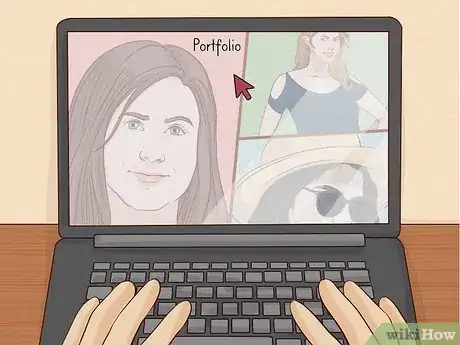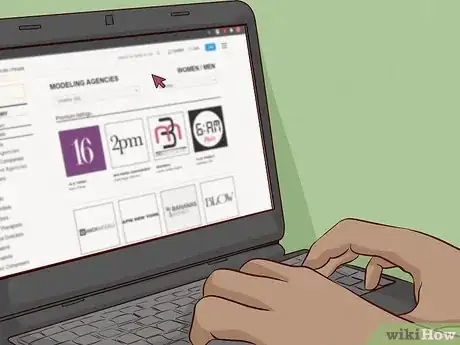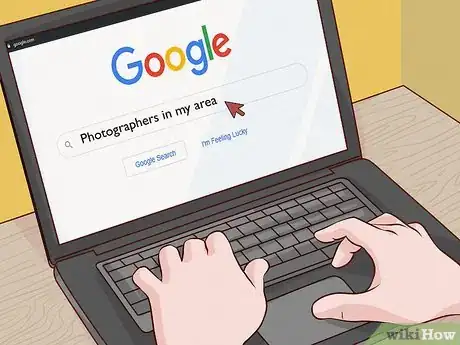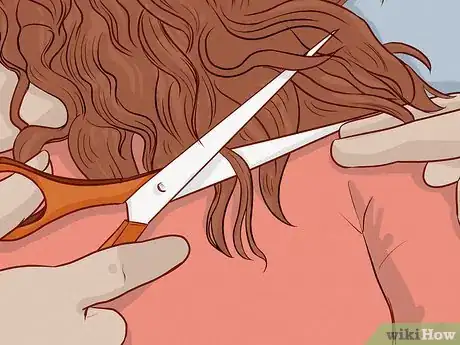This article was co-authored by Melynda Choothesa. Melynda Choothesa is a Costume Designer, Wardrobe Stylist, and Art Director with over 10 years of fashion consulting experience. She has worked on creative direction for fashion shows, costume design, and personal wardrobe styling, both in Los Angeles, California and internationally for clients such as Akon, Kathy Ireland, and Aisha Tyler. She has an Associate of Arts in Fashion Design from Santa Monica College.
There are 13 references cited in this article, which can be found at the bottom of the page.
This article has been viewed 113,153 times.
If you’re hoping to land your first modeling job, the good news is that there are tons of jobs out there for the taking. You just have to know how to find them and make a great impression, and we’re here to help! This article will teach you how to put together a stellar portfolio, find modeling jobs near you, and prepare for go-sees and casting calls so you have the best chance of getting hired.
Steps
Preparing Your Portfolio
-
1Take your measurements. Since most modeling jobs have particular types of models in mind, you should have a clear understanding of your own physical attributes. If you’re a woman, measure your chest, waist, and hips, and verify your height and weight. If you’re man, measure your shoulders, waist, and inseam, as well as your height and weight.
-
2Decide what type of modeling you want to pursue. As art comes in many forms, there is a wide range of modeling options. Your headshots and portfolio should emphasize your physical attributes and personality, based on the type of modeling jobs that you want to pursue.
- If you’re interested in becoming a fashion model, the most exclusive type, the physical standards are quite strict. For example, female models must be “fashion-industry size-standard”, which means you must be 5’9” to 6” tall, have measurements of 34-24-24, wear clothing size 0-4, and weigh between 105-130 pounds, proportional to your height.
- An “alternative” or “alt” model, on the other hand may not fit the industry standard. Many have tattoos and piercings, as well as atypical hairstyles.
- Catalog models can be a range of sizes and shapes as well, depending on the clothing designer and retailer.[3]
Advertisement -
3Have professional pictures made. Find a reputable photographer who specializes either in model photography or in headshots. Make sure that you have access to the negatives, too,so that you can build your own composite card and portfolio.
- Ask the photograph to help you to keep them simple and natural. Modeling agencies and clients are looking for confident models who seem relaxed in front of the camera, not potentially awkward poses or false “glamour.”[4]
-
4Make composite cards. A composite is an important marketing tool, much like a business card, that agencies and clients will keep as a reference for you. It consists of a single page, often a 5x7 card, and sometimes a full 8.5x11 sheet, that has your headshot on one side and several photos with your vital statistics (physical characteristics and personal qualities) on the back. [5]
-
5Create physical and digital portfolios. Use your photographs to create an attractive portfolio to carry to go-sees, cattle-calls, and agency interviews. This portfolio should represent the range of your expressiveness and emphasize your personal style and physical attributes.
- For instance, if your emotional expressiveness is your best quality, then select images that highlight the way you show emotion in different lights, with different make-up, and in different contexts.
- A digital portfolio, such as a DVD or flash drive, might be a useful investment, especially if you’re interested in modeling for television or the catwalk. You can include video footage of your walk or your previous video modeling experience.
Freelancing as a Model
-
1Consider working as a freelance model. If you live in a big city, such as New York or Los Angeles, then having an agent is ideal. However, if you live in a small or mid-size city with a population of less than one million, then you may want to consider working as a freelance model. While agencies in large cities will often cover the cost of things like headshots, agencies in smaller cities will not and they may also charge more for their services in order to stay in business.[6]
- Keep in mind that working as a freelance model will mean that you are in charge of your own booking, development, billing, and dispute resolution. If you do not think that you are up to the task, then try to find an agent.
-
2Network with people in the modeling industry. Networking is a great way to meet models and people in the modeling industry who can help you to find modeling jobs. Networking involves meeting people, getting to know them in a casual, conversational way, and then asking them for suggestions and advice about how to find jobs.
- Attend modeling industry events in your area. Mixers, parties, and other events can offer you some great networking opportunities. Make sure that you add these events to your calendar and start making yourself a regular presence in the modeling world.
- Try to meet people who have influence. For example, someone who hires models for a magazine is more influential than someone who has modeled for that magazine.[7] However, keep in mind that someone who it not influential today may be influential tomorrow, so be nice to everyone.[8]
- Be friendly and engaging. It may be tempting to start talking about your career and as for help finding a job, but this is a mistake. Instead, try to have a nice, friendly conversation with everyone you meet. Ask questions, listen, and show genuine interest.[9]
-
3Set up an online portfolio. Whether you plan to freelance or work with an agency, consider setting up a web site as another kind of digital portfolio. As a marketing tool, a web site under your own name will make you easier to find, and you can direct potential clients to a wider variety of your work.[10]
- Social media sites are not as professional as a web site, and so potential clients might not take you seriously. In addition, on a web site of your own, you have control over the content and the format in a way that you do not on social media.
- Make sure that your web site is attractive, professional, and easy to navigate. Potential clients want to get to your pictures and reel quickly, so make links to your work as clear as possible.
-
4Add your name to credible model listing sites. These sites are a clearinghouse for models seeking work and clients looking for models. Most of them require membership fees, but a few reputable free sites do exist.[11]
- Many sites allow you to tag your modeling interests, such as fashion, athletic, or parts modeling.
- These sites often include photographers, too, so you can make new contacts with professionals in that field and further build your portfolio.
- Use caution when listing your name and photographs online. Some of these listing sites have raised significant concerns about predators posing as photographers or agents. Models have been sexually assaulted or have gone missing after responding to a false casting call or contact.[12]
-
5Make the rounds. Use an Internet search to identify businesses in your area that might employ models, such as photographers, graphic design firms, casting companies, and advertising agencies. “Cold call” them by going by their front office and dropping off your composite.[13]
- You can also “cold call” by telephone and follow up with an email of the composite as an attachment, although it’s wise to meet the client in person so that you can show them your friendly and relaxed personality.
- Check your city’s yellow pages or local business directory for businesses and their contact information. You can find these directories in most local libraries.
-
6Go to open casting calls. Search the Internet or your local paper for open casting calls for models in your area. These calls may be for anything from local fashion shows to television commercials, so be open to the challenge of different kinds of modeling situations.
- Consider charity fashion shows for the experience and portfolio building, even if you're not paid for your work.
- Be sure that the open casting is for a legitimate client and is not a scam or a dangerous situation. If you have any concerns, take a friend with you to the call or photo shoot.[14]
- Know the signs of a modeling scam, such as unsolicited direct contact from a photographer, filmmaker, or advertiser.[15] [16]
-
7Treat modeling like a day job. If you want to be successful as a model, you'll need to work hard at obtaining work every day. Thought the life of a model may seem glamorous, the most highly-paid models make their career their focus, and not the night life.[17]
- Just like you would at your day job, always be professional. Modeling agents are more willing to work with people who are professional and able to take direction.[18]
- Plan to do at least one significant thing every day to further your career, whether that's making a call or visit to a potential client, working on your portfolio, or searching for jobs online.
-
8Consider other fields in your career. A number of highly successful models have discovered other careers related to modeling, but in other areas, such as acting, hosting, and photography. Be willing to change direction if you're no longer suited to your preferred modeling style, or if you're not finding the success that want.
Working with a Model Agency
-
1Apply to reputable agencies. An agency will manage and promote your modeling career, marketing you to clients, fashion shows, and online, and helping to arrange jobs based on your availability and assets.[19]
- Most agencies take a standard 20% commission from your earnings.
- Being a part of an agency does not mean that you’re guaranteed work, though you should feel that they’re marketing you appropriately.
- Some non-exclusive agencies will allow you to sign with other agencies, so that you have even more opportunities for modeling jobs.[20]
-
2Go to open castings for agencies and clients. Some agencies will offer open casting calls for new talent, so add those dates to your calendar and be prepared for a go-see or a cattle-call.
- Be sure that the open casting is for a legitimate agency and is not a scam or a dangerous situation. If you have any concerns, take a friend with you to the call or photo shoot.[21]
- Know the signs of a modeling scam, such as unsolicited contact from a photographer or agency, or the requirement for a down payment or fees in advance of your acceptance to the agency.[22] [23]
-
3Take your contract to a lawyer before you sign it. Most contracts are biased towards the agency, but always contact a lawyer before signing any documents. The terms of an agency contract are always negotiable, so review the document with a lawyer and propose any changes to the agency before deciding whether or not to sign.[24]
-
4Manage your finances carefully. Modeling for an agency, especially at the beginning, can be expensive, as you will need start-up costs for marketing, such as for your composite cards and messenger services between the agency and the client. Agencies often bill these expenses were billed to your future earnings, so that it may take some time to see any pay at all.
- Foreign models may need to pay the agency for travel expenses, and so may be deep in debt before they’ve begun working.
-
5Keep in touch with your agency representative. Make sure they’re promoting you on a regular basis, and ask if you need to do anything else to be more marketable. If your agency is not doing a good job of finding work for you or you do not like the way that they are marketing you, then you may want to consider looking for a new agent or going freelance.
Preparing for the Go-See or Cattle Call
-
1Review your portfolio and composite. After reading the casting call, take some time to go over your photos and portfolio. Ask yourself: does my portfolio meet the expectations of this client? Do my pictures seem to fit with the client’s style? If you answered “no” to either question, then consider taking new pictures or, at least, updating your portfolio and composite to be more specific for this job.
-
2Practice your expressions in front of the mirror. Even if you feel confident in front of a camera, applying for a job is a stressful situation. Watching yourself make expressions will not only help you to make those movements more natural, you’ll learn how they “feel” on our face, so that, during the go-see, you’ll be confident that you’re showing the client what they want to see.[25]
-
3Take care of your skin and body. In the days or weeks before the go-see, pay extra attention to your health. Make sure that you’re eating healthy foods that are high in vitamins and antioxidants, in order to reduce any inflammation of the skin or body. Exercise to keep your muscles toned, and use gentle products on your skin and hair to reduce the chance of irritation or oiliness.
- Make sure that you eat enough; undereating can lead to irritability and disorientation, which could cause a mistaken impression of your personality during the go-see.
- Get enough sleep so that your skin can replenish itself and so that you don’t have circles or bags under your eyes.
-
4Make an appointment for a haircut. Although you want to look as relaxed and natural as possible in the casting call, you should still sharpen up your usual look. Get a trim to reduce split ends or try a new style to update your look.
- Try to schedule your hair appointment for a few days before the casting call. This will allow your new haircut to settle and give you a chance to play around with it as well.
-
5Choose casual clothing. Most potential clients want to see someone with a natural look that they can dress up or down. Try wearing nice jeans and a t-shirt with medium-heels. Wear minimal make up, such as blush and lip gloss, so that they can see your face as a palette.[26]
- Avoid trying to appear “glamorous,” as that might not be the style they want, and many aspiring models may not yet be able to pull off that look.
-
6Arrive early and prepared. Have your portfolio and composite on hand, as well as knowledge about the agency’s and the client’s styles. Modeling can be fun, but it’s also a professional industry, so treat every call as a serious job interview. If you take yourself seriously, the client will, too.
-
7Show your sunny personality. The successful models are not self-involved diva-types. In fact, the most highly recognizable faces in the industry are genuinely friendly and open with photographers and other members of the profession. In the call, have a positive attitude about modeling, about yourself and your willingness to learn, about the agency, and about the client. This attitude will help you survive the many rejections, but also let your potential client know that you’ll be enjoyable to work with.[27]
- Be as warm and genuine as you can. You don’t need to be falsely charming to get a modeling job. Instead, be the best version of yourself: natural and relaxed in any context.
- Answer questions about experience honestly, but with the confidence that you can learn.
Expert Q&A
-
QuestionWhat qualifications do you need for modelling?
 Melynda ChoothesaMelynda Choothesa is a Costume Designer, Wardrobe Stylist, and Art Director with over 10 years of fashion consulting experience. She has worked on creative direction for fashion shows, costume design, and personal wardrobe styling, both in Los Angeles, California and internationally for clients such as Akon, Kathy Ireland, and Aisha Tyler. She has an Associate of Arts in Fashion Design from Santa Monica College.
Melynda ChoothesaMelynda Choothesa is a Costume Designer, Wardrobe Stylist, and Art Director with over 10 years of fashion consulting experience. She has worked on creative direction for fashion shows, costume design, and personal wardrobe styling, both in Los Angeles, California and internationally for clients such as Akon, Kathy Ireland, and Aisha Tyler. She has an Associate of Arts in Fashion Design from Santa Monica College.
Fashion Designer You need to be someone who takes directions really well, who is extremely professional and courteous, someone who doesn't argue, and who is not difficult. Also you need to be really clear with people about your expectations and your boundaries way in advance, so that they have the option of using you or not.
You need to be someone who takes directions really well, who is extremely professional and courteous, someone who doesn't argue, and who is not difficult. Also you need to be really clear with people about your expectations and your boundaries way in advance, so that they have the option of using you or not. -
QuestionIs it legal for a teenager to work as a model?
 Community AnswerYes. There are kids working as models! You will need your parents' permission, and they will have to sign contracts for you, but it's perfectly legal for you to model.
Community AnswerYes. There are kids working as models! You will need your parents' permission, and they will have to sign contracts for you, but it's perfectly legal for you to model. -
QuestionHow do l make a portfolio?
 Dahlia GillespieCommunity AnswerYou have to have a photoshoot. Get an agency or a photographer who does model portfolios. Get your best outfits and pose. Not a lot of make up and different styles are required. When you have all your photos done you can send them to the model agency.
Dahlia GillespieCommunity AnswerYou have to have a photoshoot. Get an agency or a photographer who does model portfolios. Get your best outfits and pose. Not a lot of make up and different styles are required. When you have all your photos done you can send them to the model agency.
Warnings
- Sexual harassment and abuse is never an acceptable practice. Consenting to be photographed is not the same as consenting to sexual assault, even if you’ve agreed to nude photographs. A photo release is only permission to use your image, not exploit your body in any way.⧼thumbs_response⧽
- Always be vigilant about modeling scams. If you have suspicions or doubts, research the photographer or agency, or simply keep looking for other options.[29] [30]⧼thumbs_response⧽
References
- ↑ http://www.newhealthguide.org/When-Do-Men-Stop-Growing.html
- ↑ Melynda Choothesa. Professional Stylist & Fashion Designer. Expert Interview. 17 April 2019.
- ↑ http://modelmentors.com/types-of-modeling/
- ↑ https://www.fashion.net/howto/fashionmodel
- ↑ http://modelingadvice.com/FindWork.html
- ↑ http://modelingadvice.com/ModelingAgency.html
- ↑ http://www.inc.com/minda-zetlin/8-things-power-networkers-do-make-connections.html
- ↑ http://www.forbes.com/sites/theyec/2014/07/28/how-to-network-the-right-way-eight-tips/
- ↑ http://www.forbes.com/sites/theyec/2014/07/28/how-to-network-the-right-way-eight-tips/
- ↑ http://modelingadvice.com/FindWork.html
- ↑ http://modelingadvice.com/FindWork.html
- ↑ http://modelalliance.org/modeling-scams
- ↑ http://modelingadvice.com/FindWork.html
- ↑ http://modelingadvice.com/FindWork.html
- ↑ http://modelalliance.org/modeling-scams
- ↑ http://www.consumer.ftc.gov/articles/0071-look-out-modeling-scams
- ↑ https://www.fashion.net/howto/fashionmodel
- ↑ Melynda Choothesa. Professional Stylist & Fashion Designer. Expert Interview. 17 April 2019.
- ↑ http://www.ukmodels.co.uk/jobs/
- ↑ http://modelmentors.com/become-a-freelance-model/
- ↑ http://modelingadvice.com/FindWork.html
- ↑ http://modelalliance.org/modeling-scams
- ↑ http://www.consumer.ftc.gov/articles/0071-look-out-modeling-scams
- ↑ http://modelalliance.org/modeling-scams
- ↑ http://www.seventeen.com/fashion/style-advice/tips/a19348/todd-anthony-tyler-breaking-modeling-industry/
- ↑ http://modelingadvice.com/FindWork.html
- ↑ http://www.seventeen.com/fashion/style-advice/tips/a19348/todd-anthony-tyler-breaking-modeling-industry/
- ↑ Melynda Choothesa. Professional Stylist & Fashion Designer. Expert Interview. 17 April 2019.
- ↑ http://modelalliance.org/modeling-scams
- ↑ http://www.consumer.ftc.gov/articles/0071-look-out-modeling-scams
About This Article
To get a modeling job, first choose what type of modeling you'd like to do, like high fashion or catalog modeling. Then, take at least 3 headshots in different settings or environments, and use these as your portfolios when you’re applying for jobs. Additionally, use one of these photos to print out composite cards, which have your headshot on the front and your important information, like your measurements and contact details, on the back. Once you have your portfolio, look for open casting calls online and send in your portfolio to be considered. If you want more advice on how to get a modeling job, including how to find an agent, keep reading!





















































































